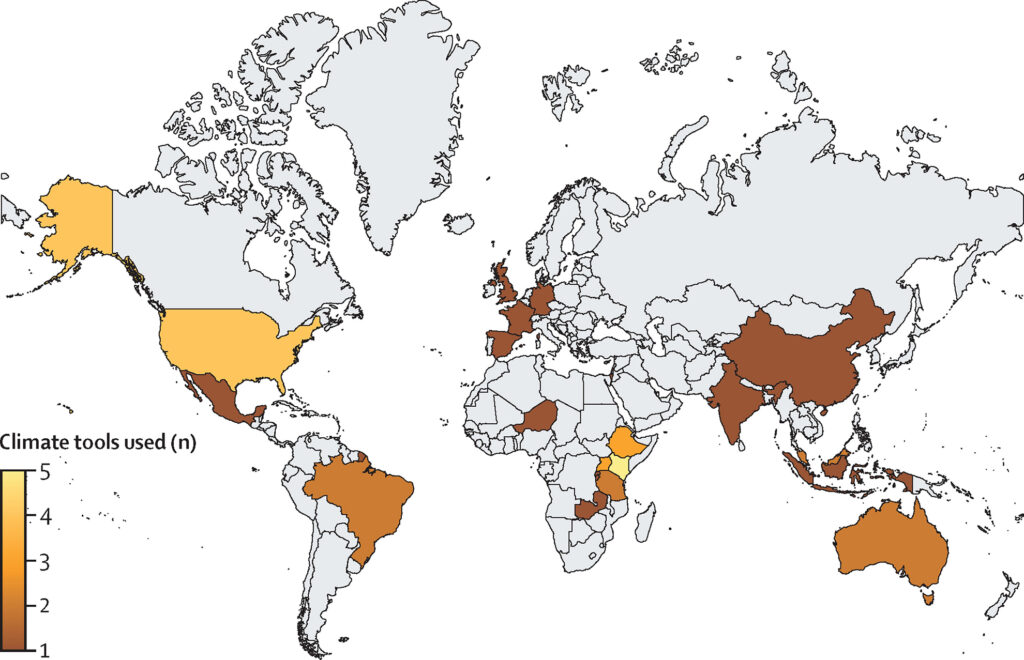By Lauren Barnett, University of Florida College of Liberal Arts and Sciences
As climatic conditions and population growth set the stage for more frequent infectious disease outbreaks around the globe, a new study sheds light on the limited availability of software tools that can accurately forecast their risks. The study, led by UF medical geographers Sadie Ryan and Cat Lippi, was published this week in The Lancet Planetary Health. It highlights the urgent need for more diverse and accessible software tools to predict and manage risks associated with climate-sensitive infectious diseases.
The study revealed that only 37 fully developed software tools exist that can accurately predict the risks of climate-sensitive infectious diseases (CSIDs) based on climate and epidemiological data. There’s also a flagrant disparity among the tools: The majority (81%) focus on “vector-borne” diseases that are transmitted to humans by organisms like mosquitos, such as malaria and dengue fever. Since new patterns of precipitation and rising temperatures influence the survival and reproduction rates of disease-carrying mosquitos and ticks, preventing and controlling vector-borne CSIDs remains crucial.

However, a slew of other environmental conditions linked to climate act as increasing threats to public health. Severe droughts and floods are on the rise, affecting patterns in foodborne or waterborne infectious diseases. Changes in climate and air quality can cause an increase in respiratory diseases, such as influenza. And from below, pathogens in the soil threaten agriculture. Ryan and her team found a shortage of tools available to address diseases spread from the water, air and food — only 10% focus on these types of CSIDs. Alarmingly, no tools for modeling soil-borne diseases currently exist.
“There are many infectious agents that are sensitive to climate change, and we simply don’t have many developed software tools to model them,” said study co-author Cat Lippi, a postdoctoral researcher in Ryan’s lab group. “Promoting the creation of novel tools will aid in anticipating when and where disease outbreaks occur.”
“While we are in a time of increasing awareness of the links between climate and health, the resources and capacity for developing and testing these types of modeling tools are scarce,” Ryan said. “We hope this type of study serves to motivate onward efforts.”
Ryan, a principal investigator in the Emerging Pathogens Institute and co-director of the Florida Climate Institute at UF, aims to inform public health planning and policy. Her research investigates how disease outbreaks can be better controlled, effectively shaping how we manage infectious disease risks.
Ryan explains that we will continue to experience shifting risks of infectious diseases in a changing world. “A key element of the research we do is to provide part of a toolkit to anticipate these shifts, allowing for adaptation of strategies and informing decision makers across the realms of health and environmental interventions.”
The study reveals a troubling gap in representation: North American and European institutions dominate the development of climate modeling tools. This presents a critical research gap, as the geographic locations commonly prioritized for the study of infectious diseases are often in the Global South. The areas of the Global South hardest hit by climate-disease impacts are commonly left out of the conversation. The authors advise prioritizing the development of new partnerships throughout these hardest-hit regions, so local researchers and decision-makers can best help mitigate future outbreaks.

One bit of good news: The study found that over half (54%) of the software tools are freely available online, providing a valuable open-access resource for public health planning.
“It is important that the research world meets the challenges of applied use of this type of modeling tool, and accessibility is a barrier easily lowered via open and transparent availability,” said Ryan.
Public health researchers will benefit from the guidance provided by the study. New tools must be developed, with intention and accuracy, to ensure we are prepared for the future.
Read the full study here.
This piece was originally published at https://news.clas.ufl.edu/climate-change-public-health-modeling-tools/
Sign up for The Invading Sea newsletter by visiting here.



